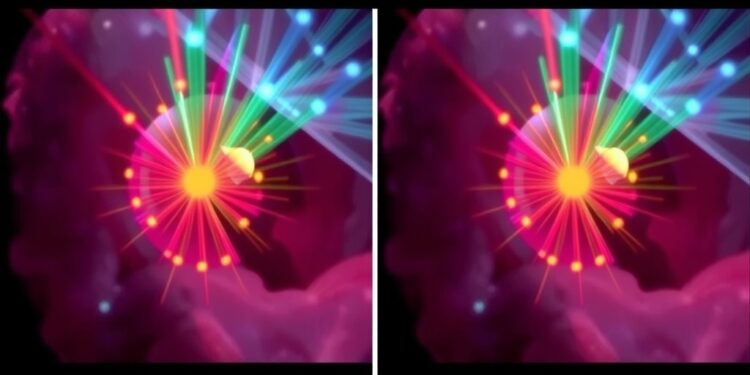
In the cutting-edge landscape of optical technology, multimode fibers (MMFs) stand out as a transformative medium with vast potential. These fibers are celebrated for their ability to accommodate a plethora of guided modes, a staggering range from approximately 1,000 to 10,000. This remarkable capacity allows MMFs to facilitate high-bandwidth communication and intricate imaging applications, which are vital in contemporary sectors such as telecommunications and biomedicine. However, the very properties that endow MMFs with their capacity also give rise to a critical drawback: significant modal dispersion. This phenomenon complicates the transmission of clear and accurate information, a persistent hurdle for researchers and engineers in the field.
Despite the advances made in image reconstruction technologies that utilize artificial neural networks (ANNs) and spatial light modulators (SLMs), the challenge of maintaining optical fidelity during transmission remains formidable. The inherent scattering nature of MMFs creates a substantial barrier for clear image transport. Current methodologies, while noteworthy, often yield results that fall short of achieving pristine transmission. This tantalizing gap in the field has spurred scientists and researchers to pursue innovative solutions that sidestep or mitigate the constraints posed by traditional optical transmission techniques.
Emerging from this quest is a pioneering study led by Prof. Qiming Zhang and Associate Prof. Haoyi Yu from the University of Shanghai for Science and Technology. This research has unveiled a groundbreaking integration of diffractive neural networks (DN2s) directly onto the distal end of MMFs. By leveraging the power of miniature multilayer optical networks, researchers have created a new paradigm for image transmission that does not merely reconstruct but instead transmits images in their original optical form.
The integration of DN2s represents a notable shift from conventional ANN approaches. Traditional neural networks process information digitally, introducing latency and constraints inherent in electronic computations. Conversely, DN2s operate via optical matrix multiplication, a process conducted at the pinnacle of speed—the speed of light. This fundamental shift is monumental in expediting image processing, rendering it feasible to tackle complex tasks such as optical image classification and decryption with unprecedented efficiency.
Crafted through a meticulous fabrication technique known as 3D galvo-scanning two-photon nanolithography (GS-TPN), the DN2s developed in this research boast a mere 150 μm by 150 μm footprint. This remarkable scale enables their seamless integration with a standard 0.35-meter-long MMF, creating a compact and efficient system suited for practical applications. The ability of these diffractive neural networks to function effectively operating in the visible wavelength range further underscores their versatility and potential widespread adoption.
These innovative systems exhibit a robust ability to infer both amplitude and phase information from speckle patterns encountered during MMF transmission. This capability translates directly into high-quality image reconstruction, allowing for real-time visual information to traverse the fiber without distortion. The system demonstrated exceptional performance in imaging tasks, including the reconstruction of handwritten digits. Results showcased a minimum image feature size of about 4.90 μm, illustrating the potential precision of this optical inference platform.
Moreover, the average optical intensity contrast achieved by the system is reported at around 4%. This level of performance is particularly notable when considering the challenges of working with MMFs. The incorporation of 35% diffraction efficiency per layer enhances the system’s viability for practical applications, promising enhanced capabilities for future optical communication and image processing technologies.
Importantly, the research indicates a significant learning characteristic inherent in the DN2s system. While transmitting images of HeLa cells not included in the initial training dataset, the platform managed to reconstruct these images with maintained quality. This demonstrates not only the adaptability of the system but also its potential for generalizing beyond its training scope. This adaptability paves the way for broader applications, extending the utility of DN2s in fields ranging from medical imaging to advanced quantum state transfer.
Looking ahead, this breakthrough holds immense promise for transforming compact photonic systems and multimode fiber technologies. The synergistic integration of DN2s opens avenues for multifunctional applications, including rigid endoscopes, efficient signal transmission through MMFs, and even sophisticated quantum optical interconnects. The research team’s successful melding of optical computing capabilities with fiber optic technologies stands to significantly impact the evolution of both fields.
As the domain of optics continues to expand, the introduction of diffractive neural networks could herald a new era in imaging and communications. This innovation not only improves upon existing limitations but also sets the stage for developing novel applications that leverage the unique advantages of MMFs. The implications resonate across various scientific and technological landscapes, hinting at the vast potential that lies within enhanced multimode fiber systems.
In summary, the integration of miniaturized DN2s with MMFs signifies a monumental leap in optical image transmission technology. The ability to process and transmit images directly through fiber with minimal distortion carries profound implications for future research and application. As the world becomes increasingly interconnected through optical communication technologies, advancements like these promise to enhance the fidelity of information carried through fibers, thus driving forward the frontiers of science and technology.
By continuing to explore and innovate within this domain, researchers can unlock even more capabilities and applications, illustrating the extraordinary potential of multi-mode fibers combined with advanced optical systems. The future of optical communication and imaging looks brighter than ever, thanks to pioneering studies such as this one.
Subject of Research: Optical Image Transmission through Multimode Fibers
Article Title: All-optical image transportation through a multimode fibre using a miniaturized diffractive neural network on the distal facet
News Publication Date: October 2023
Web References: Nature Photonics
References: N/A
Image Credits: N/A
Keywords
Optical fibers, multimode fibers, diffractive neural networks, image transmission, optical computing, quantum optics.
Tags: artificial neural networks for image reconstructionchallenges of modal dispersion in opticsdiffractive neural networks in imaginghigh-bandwidth communication in biomedicineminimally invasive endoscopy technologymultimode fiber optics applicationsnovel solutions for image transport challengesoptical fidelity in multimode fibersoptical image transmission innovationsoptical imaging advancements in healthcarespatial light modulators in endoscopytransformative optical technologies in telecommunications





